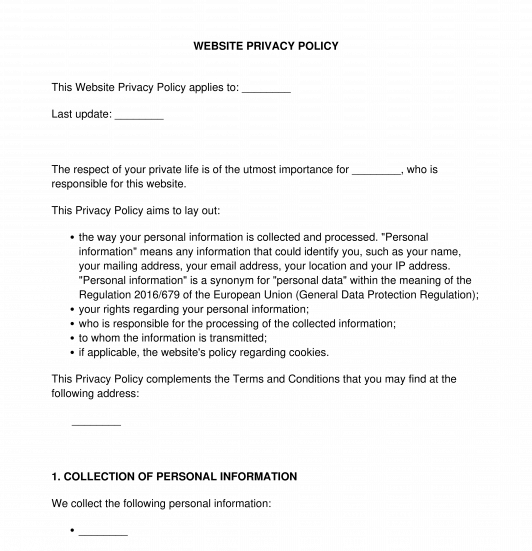 09/09/2025
09/09/2025

Answer a few questions and your document is created automatically.

Your document is ready! You will receive it in Word and PDF formats. You will be able to modify it.

 09/09/2025
09/09/2025
 Word and PDF
Word and PDF
 5 to 8 pages
5 to 8 pages
A Website Privacy Policy is a document that explains to visitors or users of a website the personal information that the website collects when they browse its pages. This document also explains how the personal information is collected, the reasons personal information is collected, and the rights that users or visitors have in relation to these practices.
A Privacy Policy is different from the Terms and Conditions of a website. On one hand, a Website Privacy Policy agreement is required if a website collects personal information from its users, e.g. email addresses, first and last names, etc. The purpose of the Website Privacy Policy is to inform users about the collection and use of personal data. On the other hand, the Terms and Conditions set forth terms, conditions, requirements, and clauses relating to the use of the website, e.g. copyright protection, accounts termination in cases of abuse, and so forth.
"Personal information" means any information that identifies an individual, such as: surnames, first names, postal and electronic addresses, telephone, credit card, social security or social insurance numbers, the date of birth, etc.
Where applicable, this document can adopt European Regulation 2016/679.
How to use this document
The collection of personal information concerns only the personal information that is necessary to obtain a service or property.
This privacy policy includes the following:
Opposition measures to collection: right of objection, right of withdrawal and right of access
This privacy policy provides opposition measures for users, which the company or organization must respect and implement at the request of a user. These opposition measures include the right of withdrawal, right of access and right of objection.
The right of objection allows users to refuse to have their personal information used for certain purposes mentioned at the time of collection. For example, it would be possible to agree to give one's information, but to oppose to its disclosure to third parties, listed on the mailing list of the website or, used for business purposes.
The right of withdrawal allows users to request that their personal information be removed from mailing lists.
The right of access allows users to know what personal information is held by the owners of the website, with the possibility of updating it.
In order for the Website Privacy Policy to be legally binding on a user of the website, the user will have to actually be aware of such. Therefore, the Website Privacy Policy will need to be published on the website. Organizations owning a website also need to consider the most appropriate form for consent, express or implied; express consent is generally required. As a consequence, there may be a need for a mechanism registering the express consent of the users before accessing the website.
Applicable law
Personal Information Protection and Electronic Documents Act, SC 2000, c 5 or any substantially similar provincial legislation and General Data Protection Regulation, Regulation (EU) 2016/679 of the European Parliament and the Council of 27 April 2016 on the protection of natural persons with regard to the processing of personal data and on the free movement of such data, and repealing Directive 95/46/EC, and other relevant Canadian cyber laws.
How to modify the template
You fill out a form. The document is created before your eyes as you respond to the questions.
At the end, you receive it in Word and PDF formats. You can modify it and reuse it.
Website Privacy Policy - Template - Word & PDF
Country: Canada (English)